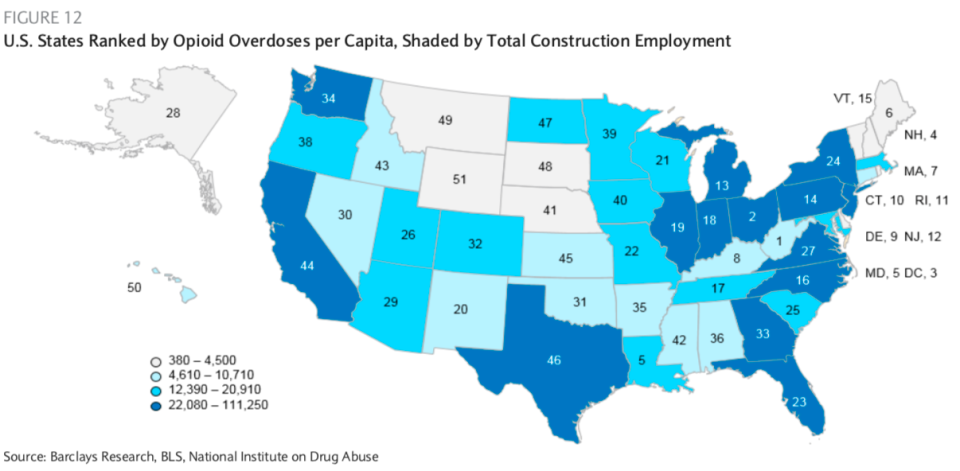The opioid crisis is hitting one industry particularly hard
As opioid addiction increased exponentially over the last two decades, American construction workers have been among those hit the hardest.
According to a note from Barclays Research, construction workers are nearly six times more likely than other industries to develop an opioid addiction. “In Massachusetts,” the analysts noted, “~25% of all opioid overdose deaths were from construction.”
Chris Cain, the executive director of The Center for Construction Research and Training (CPWR), stressed that the trend is less “about a worker who’s in the industry” than “about the construct of the industry.”
“Workers have to work in pain,” she told Yahoo Finance. “That’s a problem, but that’s the way the industry is right now, and changing the industry is a longer-term effort than what we can do today. But that’s kind of the circumstances.”

And the nature of construction employment and turnover creates pressure on workers to be on the job whenever they can.
“There’s a lot of uncertainty when you’re a construction worker,” she said. “You work long hours and then sometimes you’re laid off, and you don’t work for weeks or months. ... So when the long hours are available, you take them and you get your overtime, but you don’t get sick days.”
She added: “You don’t get days to recover, you don’t get a good eight hours of sleep at night because you can’t turn down work when work is available.”
Several factors ‘our workers a lot more vulnerable’
Greg Sizemore, the vice president of health, safety, and environment and workforce development for the Associated Builders and Contractors (ABC), said aside from the strenuous work in construction, there are other factors that come into play as well that can lead to opioid addiction.
“I think we fall into that category where [physical labor] is one of maybe four or five things that really attribute to it,” he told Yahoo Finance. “The construction worker, just by the physical nature of their jobs, often suffers some wear and tear on their body.”

He added that there are demographics and lack of oversight also come into play.
“Aging workforce — you’ve got fewer young people coming into the business, but the young people that are coming into the business have more ready access to them than maybe in years past,” Sizemore continued. And “drug testing, particularly randoms, can be very complicated to manage in the contracting community these days.”
In terms of prescription drug spending, opioids account for 20% among construction workers, which is between 5-10% higher than other industries.
“When you’re in a situation where you don’t have economic security, you don’t have job security, you lack things like sick leave and vacation pay,” Cain explained. “There’s really a lot of factors that add to the pain of work about our industry and makes our workers a lot more vulnerable to developing substance abuse disorders.”
‘None of our companies publicly spoke to the opioid epidemic’
According to the Barclays note, “some of the highest overdose rates occur in states in the top two deciles of construction demand in the U.S., such as Ohio, Pennsylvania, Florida, North Carolina, Virginia.” For example: Although construction accounts for only 4% of total jobs in Ohio, it accounts for 13% of narcotic painkillers prescribed for on-the-job injuries.

Sizemore said leaders in the construction industry should become more proactive about addressing this problem.
“From a cultural standpoint, we have to equip our fellow employees or our employees on a project to recognize those signs and create a culture where there isn’t this fear of absolute retribution, but [rather] this opportunity to help an individual should appear,” Sizemore said.
The Barclays analysts noted that they had not heard any large engineering and construction companies address the issue on a conference call in the last year, though that may not be “the best venue to reach a company’s workforce.”
Nevertheless, discussing it on the calls “could be useful to open the door to an issue that’s being spoken about more publicly by the industry and society as a whole, but is still shroud in secrecy.”
Adriana is an associate editor for Yahoo Finance. Follow her on Twitter @adrianambells.
READ MORE:
'Just a piece': The U.S. opioid epidemic is costing a fortune in lost tax revenue
A 'really important piece of evidence' shows how opioids keep Americans out of the workforce
Read the latest financial and business news from Yahoo Finance
Follow Yahoo Finance on Twitter, Facebook, Instagram, Flipboard, SmartNews, LinkedIn, YouTube, and reddit.
